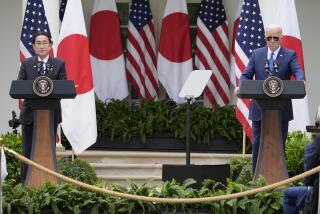THE PACIFIC SUMMIT : Technology : The Issue Isn’t Exchange--It’s How to Achieve It : Japan wants a ‘multilateral approach’ to sharing know-how. Washington worries about technical parity.
- Share via
TOKYO — Far-reaching issues of technical exchange among Pacific Rim nations will form an important sub-theme to the Seattle meeting of the Asia-Pacific Economic Cooperation forum. Potential target areas range from creating new materials for lightweight cars to cleaning up China’s polluted air.
Japan’s government wants APEC to provide a structure for technical cooperation of the kind that Tokyo has promoted in its own aid programs in Asia. These have used Japanese capital and technology to build up infrastructure, industries and human talent that boost prosperity regionwide.
“We are trying to find a multilateral approach,” explained Tsuyoshi Nakai, director of international technological cooperation at the Ministry of International Trade and Industry. “APEC can be a nice place for that.”
But Washington is lukewarm. Some U.S. officials fear that Tokyo’s proposals could sidetrack the goal of more balanced technical exchange between the United States and Japan.
The ground rules for trade talks now under way between the two nations list access to technology--which traditionally has largely flowed from the United States into Japan--as a key subject of negotiation.
“We’re trying to address access to technology as a bilateral issue, and the Japanese want to expand it into an APEC-type issue,” explained a U.S. diplomat, who spoke on condition that he not be further identified. “We’re not in total agreement with that. In some ways, it may be an attempt by the Japanese to direct the entire focus of the issue away from a bilateral problem.”
Still, U.S. representatives are participating in working groups within APEC that aim to promote greater cooperation in fields such as technical training, energy development and telecommunications. The first APEC meeting on industrial science and technology was held in Japan in September. A work plan produced at that conference, outlining principles of cooperation and dates for future meetings, is expected to receive high-level approval in Seattle, Nakai said.
Nakai described technical assistance to Asia’s developing economies as a matter of enlightened self-interest for industrially advanced nations.
“For example, we have many consumer electronics factories in Malaysia,” he said. “But many parts are coming from Japan.”
If more high-quality parts can be made by Malaysian firms, this can benefit those companies, Malaysia and the foreign firms that buy those parts, Nakai said.
“This can increase the market of this area, and all the APEC countries can enjoy the high growth of that area,” he said.
As an example of the type of cooperation Japan would like to promote, Nakai cited a Japan-Singapore research project aimed at developing composite materials using aluminum-lithium alloys that would be useful in manufacturing automobiles and many other products.
Another proposal would link research institutes in Malaysia and Japan in a study of advanced casting technology for more effective use of Malaysian resources in machine building. A Japan-Philippines project aims to develop advanced technology that uses volcanic ash for ceramics and construction.
Other APEC nations, Nakai said, are being invited to join such projects and to propose other ideas of their own.
Japan also has a deep interest in promoting clean-energy technology in China. Pollution there is bad enough to sometimes affect parts of Japan with acid rain, and to be a growing factor in the threat of global warming. This field could also become an area for APEC-based cooperation.
The United States, at least for now, seems far more concerned with the pattern of technical exchange between itself and Japan.
“One of the problems we have bilaterally with the Japanese is that there’s not an even balance in the exchange of technology,” the U.S. diplomat said. “Part of it is our fault.”
There are now about 40,000 Japanese students in U.S. educational institutions, many with access to first-class research facilities, while only about 1,400 American students are studying in Japan, he said.
In the business world, he added, much innovative U.S. research and development is done by small entrepreneurial firms.
“They go in with some money, they make a discovery and they need to recoup that money,” he said. “So they’re very open to selling that product or idea immediately.” One study showed that in 1989, for example, U.S. firms made technology sales to Japan worth about $700 million.
In Japan, technological research is usually conducted by large corporations that use the results themselves rather than selling to others.
Another factor, he said, is that U.S. companies wishing to set up research facilities in Japan face extremely high start-up costs, difficulty attracting Japanese researchers and problems of inadequate patent protection.
The result of all these differences is to reinforce the tendency for technology to flow more easily from the United States to Japan than in the reverse direction, the diplomat concluded.
Under terms of a U.S.-Japan agreement reached during President Clinton’s July visit to Tokyo, broad trade negotiations now under way between the two countries include specific talks on intellectual property rights and access to technology.
Washington wants Tokyo to take steps in these areas to ease the imbalance.
But broader action within APEC may also be boosted by the July agreement, which includes a pledge that the two governments will “build new cooperative relations and thereby contribute to the development of technology and the world economy.”
More to Read
Sign up for Essential California
The most important California stories and recommendations in your inbox every morning.
You may occasionally receive promotional content from the Los Angeles Times.













